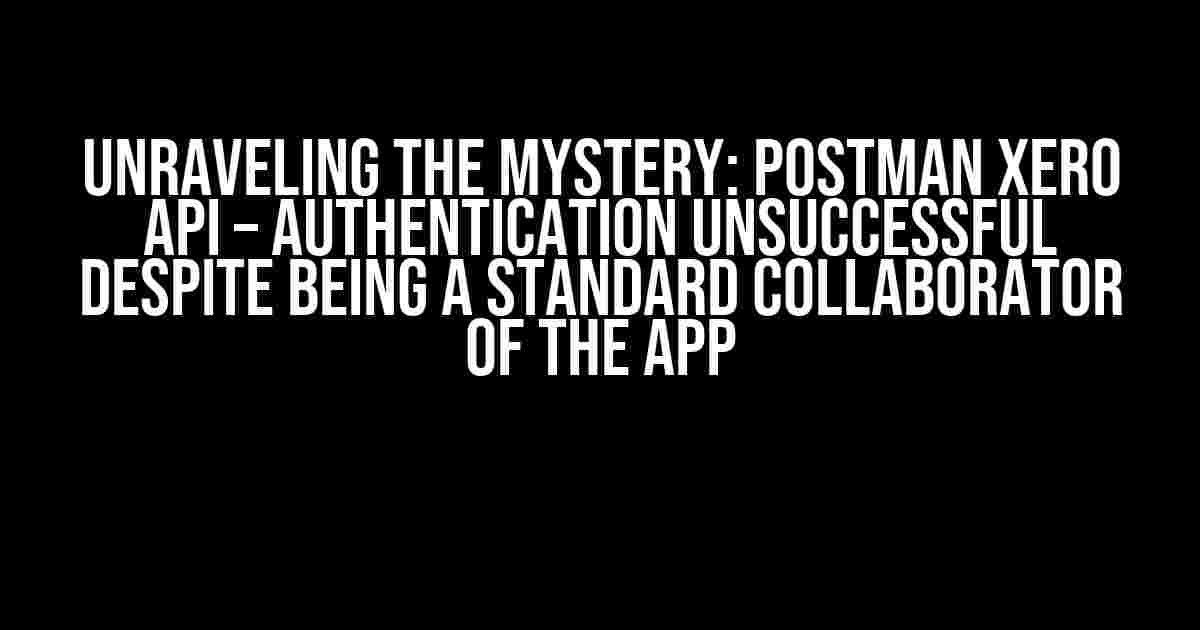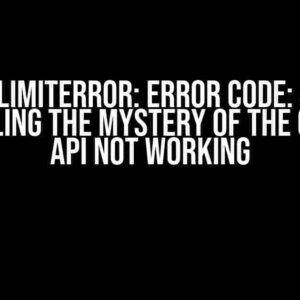Are you tired of banging your head against the wall, wondering why you’re getting an “Authentication Unsuccessful” error despite being a standard collaborator of the app in Postman Xero API? You’re not alone! This frustrating issue has plagued many a developer, but fear not, dear reader, for we’re about to embark on a journey to solve this enigma once and for all.
What’s Going On?
The first step in solving this puzzle is to understand the root cause of the problem. When you’re a standard collaborator of an app in Xero, it’s expected that you should have the necessary permissions to access the API. However, it seems that Postman has other plans.
Beneath the surface, the issue lies in the way Postman handles authentication with the Xero API. You see, when you try to authenticate with the API, Postman sends a request to Xero to obtain an access token. This token is then used to authenticate subsequent requests to the API. But, in this case, the token isn’t being generated correctly, resulting in the “Authentication Unsuccessful” error.
The Solution: A Step-by-Step Guide
Fear not, dear reader, for we have a solution to this pesky problem! Follow these steps carefully, and you’ll be accessing the Xero API in no time:
Step 1: Create a New Request in Postman
Open Postman and create a new request by clicking on the “+” button at the top left corner of the screen. Select “HTTP Request” and enter the following URL:
https://api.xero.com/oauth/authorize
This URL is the authorization endpoint for the Xero API. It’s the first step in the OAuth 2.0 flow, which we’ll be using to authenticate with the API.
Step 2: Add Query Parameters
In the request URL, add the following query parameters:
response_type=code: This tells Xero that we want to receive an authorization code in response.client_id=YOUR_CLIENT_ID: Replace YOUR_CLIENT_ID with your actual Xero client ID.redirect_uri=YOUR_REDIRECT_URI: Replace YOUR_REDIRECT_URI with your actual redirect URI.scope=offline_access+openid+profile+email: This specifies the scopes we want to request access to.
Your request URL should now look something like this:
https://api.xero.com/oauth/authorize?response_type=code&client_id=YOUR_CLIENT_ID&redirect_uri=YOUR_REDIRECT_URI&scope=offline_access+openid+profile+email
Step 3: Send the Request and Authenticate
Click the “Send” button to send the request. You’ll be redirected to the Xero authentication page, where you’ll need to enter your Xero credentials to authenticate.
Step 4: Receive the Authorization Code
After authenticating, you’ll be redirected back to your redirect URI with an authorization code as a query parameter. The URL will look something like this:
https://YOUR_REDIRECT_URI?code=AUTHORIZATION_CODE
Take note of the authorization code, as we’ll need it in the next step.
Step 5: Exchange the Authorization Code for an Access Token
Create a new request in Postman with the following URL:
https://api.xero.com/oauth/token
In the request body, add the following parameters:
grant_type=authorization_code: This specifies the type of grant we’re requesting.code=AUTHORIZATION_CODE: Replace AUTHORIZATION_CODE with the actual authorization code you received in the previous step.redirect_uri=YOUR_REDIRECT_URI: Same as before, replace with your actual redirect URI.client_id=YOUR_CLIENT_ID: Same as before, replace with your actual Xero client ID.client_secret=YOUR_CLIENT_SECRET: Replace with your actual Xero client secret.
Your request body should look something like this:
{
"grant_type": "authorization_code",
"code": "AUTHORIZATION_CODE",
"redirect_uri": "YOUR_REDIRECT_URI",
"client_id": "YOUR_CLIENT_ID",
"client_secret": "YOUR_CLIENT_SECRET"
}
Click the “Send” button to send the request. You should receive a response with an access token.
Step 6: Use the Access Token to Authenticate with the Xero API
Finally, you can use the access token to authenticate with the Xero API. Create a new request in Postman with the following URL:
https://api.xero.com/api.xro/2.0/Organisation
In the request headers, add the following parameter:
Authorization: Bearer ACCESS_TOKEN: Replace ACCESS_TOKEN with the actual access token you received in the previous step.
Click the “Send” button to send the request. You should receive a successful response from the Xero API.
Common Pitfalls to Watch Out For
As you embark on this journey, keep an eye out for the following common pitfalls that might trip you up:
- Incorrect Client ID or Secret: Double-check that your client ID and secret are correct and match the ones registered with Xero.
- Invalid Redirect URI: Make sure your redirect URI is correctly registered with Xero and matches the one used in the request.
- Scope Issues: Ensure that the scopes you’re requesting access to are correct and match the ones required by the Xero API.
- Authorization Code Expiration: Authorization codes are only valid for a short period of time. Make sure to exchange it for an access token before it expires.
Conclusion
And there you have it, dear reader! With these steps, you should be able to overcome the “Authentication Unsuccessful” error and access the Xero API using Postman. Remember to stay vigilant and watch out for those common pitfalls that might creep up on you. If you’re still having trouble, don’t hesitate to reach out to the Xero support team for further assistance.
| Keyword | Description |
|---|---|
| Postman | A popular API testing tool |
| Xero API | The API of Xero, a cloud-based accounting platform |
| OAuth 2.0 | An authorization framework used to authenticate with APIs |
| Authorization Code | A temporary code used to obtain an access token |
| Access Token | A token used to authenticate with the API |
We hope this article has been informative and helpful in resolving the “Authentication Unsuccessful” error in Postman Xero API. Happy coding!
Here are 5 Questions and Answers about “Postman Xero API – Authentication Unsuccessful despite being a standard collaborator of the app”:
Frequently Asked Question
Stuck with Xero API authentication issues in Postman? Don’t worry, we’ve got you covered! Check out these frequently asked questions to troubleshoot the problem.
I’m a standard collaborator of the Xero app, why am I still getting an authentication error in Postman?
As a standard collaborator, you might not have the necessary permissions to access the Xero API. Ensure you have the required permissions, such as “Manage accounting” or “Manage invoicing”, to authenticate successfully. Check your Xero app settings to adjust your permissions.
Have I entered the correct credentials in Postman for Xero API authentication?
Double-check that you’ve entered the correct credentials, including the client ID, client secret, and redirect URI. Make sure you’re using the correct authentication flow (OAuth 2.0 or OpenID Connect) and that your credentials are up-to-date.
Is there a specific endpoint or scope I need to use for Xero API authentication in Postman?
Yes, you need to use the correct endpoint and scope for Xero API authentication. Try using the `https://identity.xero.com/connect/token` endpoint with the `offline_access` scope. This will allow you to authenticate and obtain an access token for API requests.
Could there be an issue with the Postman environment or variables that’s causing the authentication error?
It’s possible! Check your Postman environment and variables to ensure they’re set up correctly. Verify that you’ve stored the client ID, client secret, and other credentials as environment variables, and that they’re being used correctly in your requests.
What should I do if I’ve tried all the above and still get an authentication error in Postman?
If you’ve tried all the above and still encounter issues, reach out to Xero API support or Postman community forums for further assistance. Provide detailed information about your setup, error messages, and steps taken so far to help troubleshoot the issue.



